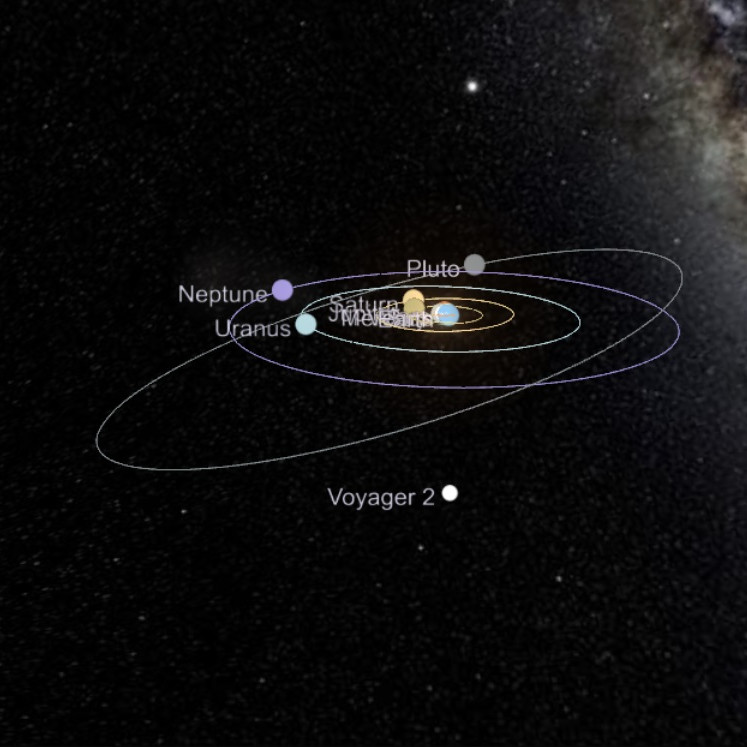 Voyager spacecraft 2 shown below the plane of the solar system with Milky Way in background.
Voyager spacecraft 2 shown below the plane of the solar system with Milky Way in background.
The Voyager spacecraft, humanity’s emissaries to the stars, have been journeying through space since the 1970s, venturing further than any other human-made object. Both Voyager 1 and Voyager 2 are now in interstellar space, racing away from our solar system. It might seem counterintuitive then, that for a few months each year, the distance between these spacecraft and Earth actually decreases. To understand this, and to truly grasp the scope of their mission, we need to delve into the question: just How Fast Is Voyager Travelling?
Voyager’s Incredible Journey and Speed
Launched in 1977, the Voyager probes embarked on a grand tour of our solar system’s outer planets. These missions were initially designed to study Jupiter and Saturn, but Voyager 2 also went on to Uranus and Neptune, providing unprecedented images and data. After their planetary encounters, both spacecraft continued their outward journey, propelled by gravity assists from the planets and their own momentum.
Voyager 1, the faster of the two, is currently travelling at a speed of approximately 38,210 miles per hour (17 kilometers per second) relative to the Sun. Voyager 2 is moving slightly slower at around 35,000 miles per hour (15 kilometers per second). To put this into perspective, these speeds are many times faster than a speeding bullet and allow the Voyagers to cover millions of miles each day. This incredible velocity is what has enabled them to travel billions of miles from Earth and enter interstellar space – the region beyond the Sun’s influence.
Earth’s Orbit: The Reason for Decreasing Distance
If the Voyagers are constantly moving away from the Sun and Earth, how can their distance to us decrease? The answer lies in Earth’s own motion. Our planet orbits the Sun at an average speed of about 67,000 miles per hour (30 kilometers per second). This is significantly faster than the speeds of the Voyager spacecraft.
As Earth revolves around the Sun, for a portion of its orbit each year, our planet is essentially “catching up” to the Voyagers from a certain angle. Imagine two cars on a racetrack, where the inner car (Earth) is faster than the outer car (Voyager). For a period, the faster inner car will reduce the distance to the slower outer car, even though both are moving forward.
This is precisely what happens with Earth and the Voyagers. For a few months every year, as Earth swings around the Sun, its faster orbital speed brings it closer to the outward-bound spacecraft, temporarily reducing the distance between them. This decrease is only temporary; the Voyagers continue their relentless journey outwards, and over the long term, the distance between Earth and the Voyagers is constantly increasing.
Voyager 2 and Astronomical Units: A Closer Look
Let’s take a closer look at Voyager 2 to illustrate this point. As an example, in early 2023, Voyager 2 was approximately 133.22 Astronomical Units (AU) from Earth. An AU is the average distance between the Earth and the Sun. Over the following months, due to Earth’s orbital motion, the distance decreased. By early June 2023, Voyager 2 was about 132.89 AU from Earth. After this point, Earth’s orbital path started to increase the distance once again.
 Voyager 2 distance from Jan 2013 to Dec 2030
Voyager 2 distance from Jan 2013 to Dec 2030
This cyclical pattern of decreasing and increasing distance repeats every year due to Earth’s orbit around the Sun. The graph visually represents this phenomenon, showing the distance of Voyager 2 from Earth fluctuating annually as Earth makes its yearly journey around our star.
In Conclusion
While the Voyager spacecraft are perpetually speeding away from Earth and our solar system, their journey is set against the backdrop of Earth’s own motion. The apparent paradox of the Voyagers sometimes getting closer to Earth is resolved when we consider the relative speeds and orbital mechanics at play. Voyager’s incredible speed is carrying them into the vastness of interstellar space, but for a brief period each year, Earth’s faster orbit brings us a little closer to these pioneering explorers.
